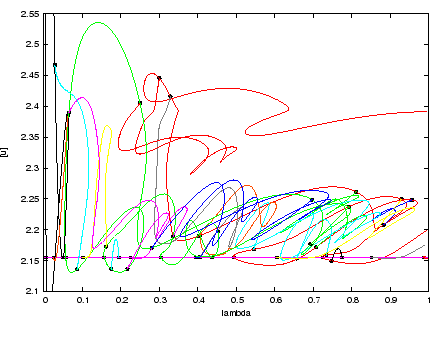Subsections
Numerical simulation of Direct Methanol Fuel Cells
Collaborator: J. Fuhrmann,
K. Gärtner
Cooperation with: J. Bloch (Freie Universität Berlin (FU-FZT 86))
Supported by: DFG-Forschungszentrum ``Mathematik für
Schlüsseltechnologien'' (Research Center ``Mathematics for Key
Technologies''
(FZT 86)),
project C1
Description:
The project has been continued with the following focuses:
The corresponding
work is closely related to the
pdelib2
project. The aim is to be able to handle efficiently calculations
in the two- and three-dimensional cases.
Fig. 1:
Three-dimensional simulation results for an elementary cell in the
case of crossing diffusion channels.
Top: methanol concentration (mol/l), bottom: water pressure (bar)
and proton potential (V)
![\makeatletter
\@DreiProjektbilderNocap[d]{0.5\textwidth}{ch3oh3d.eps}{h2o3d.eps}{hplus3d.eps}
\makeatother](img534.gif) |
Development of tools for bifurcation analysis
In close cooperation with project C1 of the DFG Research Center we
started the development of tools for path-following and bifurcation
detection for systems of partial differential equations. Once
available, this tool shall help to understand under which conditions a
fuel cell can have several steady states.
Currently, we are able to handle sufficiently well model problems like
the Brusselator equations.
Fig. 2:
Bifurcation diagram of a 1D Brusselator system in dependency
of the reactor length 
 |
We have been able to present our results at the
Computational Fuel Cell Dynamics II
workshop in Banff, Canada, and--jointly with the Micro fuel cell
group of Fraunhofer IZM Berlin--at the H2 Expo 2003 fair in Hamburg.
References:
- J. DIVISEK, J.FUHRMANN, K. GÄRTNER, R. JUNG, Performance
modeling of a Direct Methanol Fuel Cell, J. Electrochem.
Soc., 150 (2003), pp. A811-A825.
LaTeX typesetting by I. Bremer
2004-08-13
![\makeatletter
\@DreiProjektbilderNocap[d]{0.5\textwidth}{ch3oh3d.eps}{h2o3d.eps}{hplus3d.eps}
\makeatother](img534.gif)
![\makeatletter
\@DreiProjektbilderNocap[d]{0.5\textwidth}{ch3oh3d.eps}{h2o3d.eps}{hplus3d.eps}
\makeatother](img534.gif)